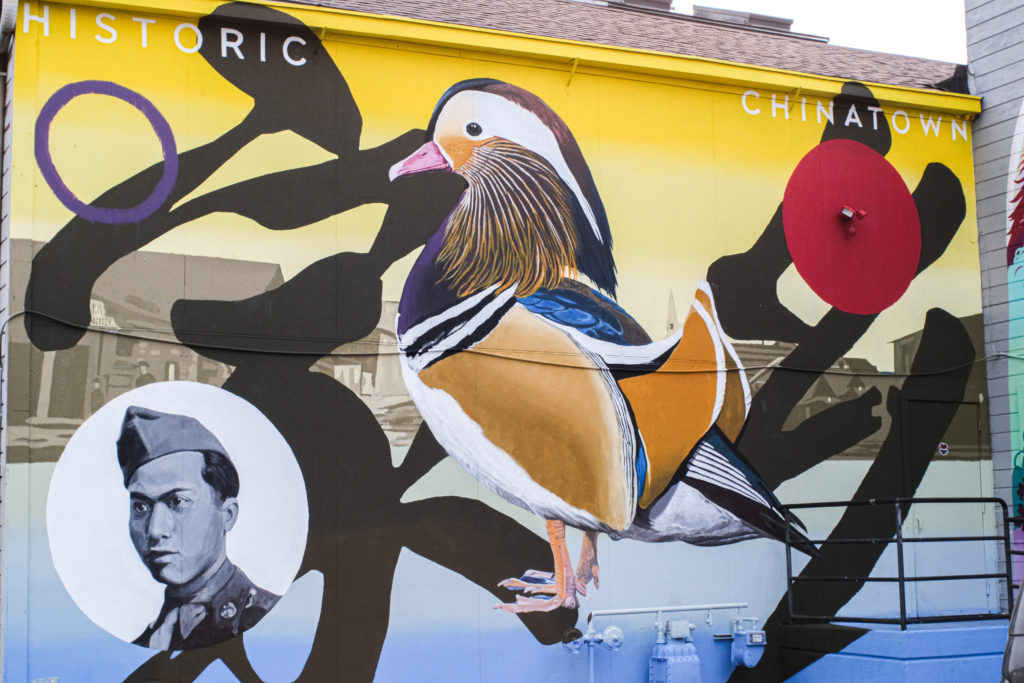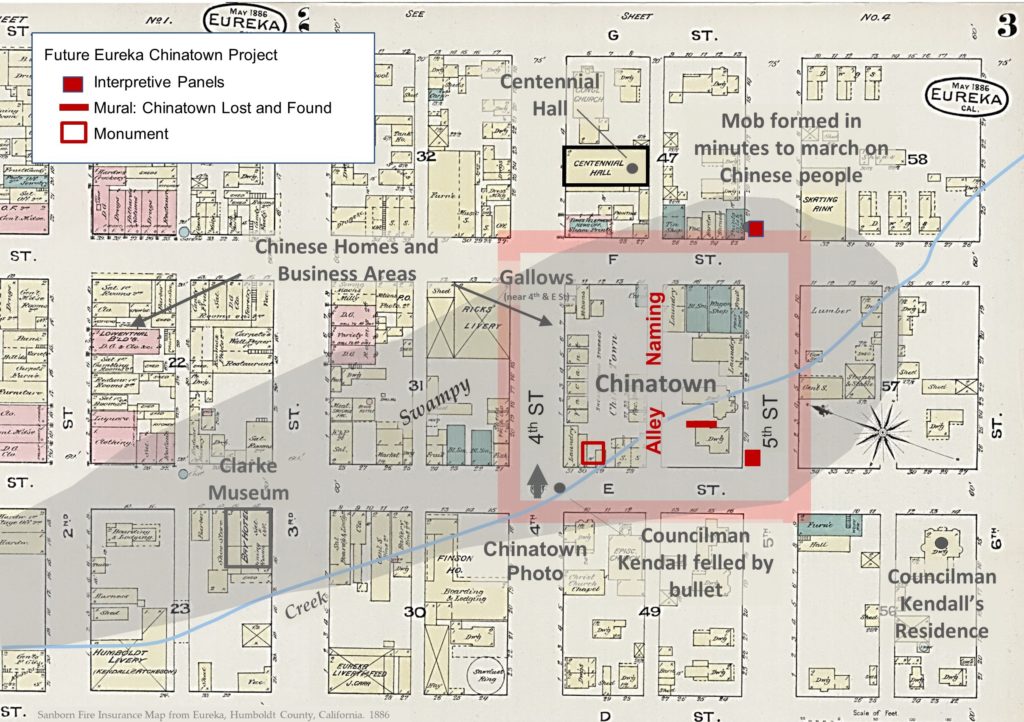Eureka Chinatown Project: Bringing attention to a forgotten past
When driving from southern Humboldt County on the 101 highway to Arcata, the highway goes through Eureka. What most people don’t realize is that they are driving through Eureka’s old Chinatown. Yet there is nothing remotely resembling nor giving a hint that there was a Chinatown between E, F, 4th and 5th streets.
The Eureka Chinatown Project is set on bringing recognition to old Chinatown and the history of its Chinese community. The project is in collaboration with Humboldt Asians & Pacific Islanders in Solidarity (HAPI) and local community members.
Brieanne Mirjah is the project coordinator of the ECP. She says this project is important and relevant.
“This is a long time coming,” Mirjah said. “It is timely, we are experiencing a lot of rage and hate throughout the country against Chinese residents. Asian American hate isn’t something new, it’s been going on for a long time.”
The ECP is opening up the narrative and inviting people to see the importance of this history and what is
missing.

How the ECP Started
“We first met in March of this year for the first time,” said Amy Uyeki, one of the founding mothers of HAPI.“And there has been a remarkable outpouring of support from the Asian American community, as well as from the community at large.”
The ECP committee began drafting out a plaque to be placed. Once they met with the City of Eureka, more
community members joined and more projects began to take form.
The hope is to bring attention to the fact that Eureka had a Chinatown, but due to the anti-Chinese sentiment growing since the 1850s and the Chinese Exclusion Act of 1882, many Chinese people were prevented from owning land, becoming citizens, and also entering into the United States.
“We’ve had stories of people in the committee that have gone to San Francisco, particularly San Francisco’s Chinatown, and told people that they were from Humboldt County or Eureka and the responses today are still in fear,” said Katie Buesch, executive director-curator of the Clarke Historical Museum.
On May 4, during a Eureka City Council meeting, Mirjah presented the Eureka Chinatown Project’s goal and projects.

Phase one:
• A mural painted on the ally going through old Chinatown,
• A self-guided tour of old Chinatown both in print and digitally,
• A monument to be erected on 4th and E streets,
• The renaming of the alley of old Chinatown (between 4th and 5th streets),
• Putting Chinatown information on the interpretive signs on the corner of 5th and F streets, and 5th and E streets
“I don’t think that anyone expected it to be an all-encompassing project but it has really become that and I think that it will really highlight the Chinatown that used to stand here,” Mirjah said.
The ECP project has already completed the mural during the Eureka Art walk in August 2021. David Y Kim, Hermosa Beach artist, painted the mural titled “Fowl.” It can be seen behind Savage Henry’s Comedy Club on 5th street.
Mirjah said that with the help of the City of Eureka, the ECP is in the process of renaming the alley that was part of old Chinatown. The interpretive signs have been repainted and will include information about old Chinatown and the history of the local Chinese community before and after the expulsion. A rough draft has been completed and is heading to the printers.
There’s an upcoming virtual walking tour in collaboration with The LifeLong Learning Lounge at Humboldt State University. The ECP will also be having a fundraising walking tour on Sept. 25.
More information can be found at hapihumboldt.org.
“What I appreciate about this project is that it’s acknowledging history, and I hope that this next generation will ask questions about this history,” said Marylyn Paik-Nicely, a founding mother of HAPI.
Some History on the Chinatown in Humboldt County
Chinatown (1850s-1885):
During the gold rush in California, people from China caught wind that there was gold in the northern rivers so they made the great migration to California. According to the US Department of State Office of the Historian, most Chinese laborers who came to the United States did so to support their families in China. At the same time, they also had to repay loans to the Chinese merchants who paid their passage to America.
The 1882 Chinese Exclusion Act:
This act was placed to stop Chinese immigration into the U.S. It also prevented Chinese people in the United States from owning land or becoming U.S. citizens.
The Expulsion of 1885:
Hatred towards the Chinese citizens of Eureka began to grow. Local news reports called them “noisy” [because of the Chinese new year celebrations] and “stinky” [due to the smell of sewage in the area caused by bad city planning]. On Feb. 6, 1885, David Kendall, Eureka City Councilman, was caught in a crossfire between two rival Chinatown gangs and was shot dead by a stray bullet. After the shooting, a mob formed and demanded that all Chinese people leave Eureka within 24 hours. According to the Clarke Museum, many did leave, they left behind their homes, businesses, and belongings, taking whatever they could on a ship heading towards San Francisco or as few newspaper reports, lived in very rural parts of the county.
The Expulsion of 1906:
The Expulsion involved the Starbuck-Talent Canning Company in Ferndale and contracted Japanese, Chinese and Russian workers. The factory had them arrive in a box cart during the night so nobody would see, but once word got out a committee of 15 was formed and demanded the factory workers to leave Humboldt County. Katie Buesch, Executive director-curator of the Clarke Historical Museum shares that at first, they resisted but eventually complied after being pressured by Eureka and other nearby towns. The workers were placed on one of the islands in Humboldt Bay to await their payment and once that was done they went to Astoria, Oregon.
Charlie Moon:
Charlie Moon was the only Chinese man in Humboldt County left after the Expulsion of 1885 (as far as we know). The story goes, Tom Bair, the ranch owner where Moon worked, was greeted by a mob from Eureka demanding that he hand over Moon. So Bear grabbed his shotgun and told a mob “You’ll have to get through me first.” The mob went back to Eureka, leaving Moon as the only Chinese man to live in Humboldt County. According to the Clarke Museum, the mob allowed Moon to stay in Humboldt County because “they americanized him.”
Ben Chin:
The first Chinese man in Eureka since 1907. Chin opened a Chinese restaurant called the Canton Café in 1954, sold it in 1970, and later opened Chin’s Café and Motel despite many threats. “He came to Eureka not knowing the history and culture here which I think is a common story for many Asian Americans that have come to this area,” said Brieanne Mirjah, project coordinator of the ECP. “People don’t necessarily know until they get here.” His presence paved the way for other Chinese and those of Asian or Pacific Islander descent to settle once again in Eureka.
Correction: Charlie Moon’s employers’ name was Tom Bair, not Tom Bear.




